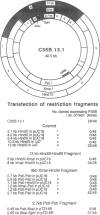Abstract
Mutagen treatment of P815 tumour cells produces tum- variants that are rejected by syngeneic mice because they express new transplantation antigens. These 'tum-' antigens elicit a cytolytic T lymphocyte (CTL) response but no detectable antibody response. The DNA of tum- variant P35 was transfected into P815 cell line P1.HTR. Transfectants expressing tum- antigen P35B were identified on the basis of their ability to stimulate anti-P35B CTL. This was repeated with a cosmid library and a cosmid carrying the sequence encoding antigen P35B was recovered from a transfectant expressing the antigen. Gene P35B is 6 kb long and contains 11 exons. The sequence shows no homology with the previously identified tum- gene P91A nor with any gene presently recorded in the data banks. The antigenic allele of gene P35B differs from the normal allele by a point mutation located in exon 5. This mutation, which replaces a Ser by an Asn residue, was shown by site-directed mutagenesis to be responsible for the expression of the antigen. A synthetic decapeptide covering the sequence surrounding the tum- mutation rendered P815 cells sensitive to lysis by anti-P35B CTL. Surprisingly, the homologous peptide corresponding to the normal sequence of the gene had the same effect, indicating that this tum- mutation does not exert its effect by generating the aggretope or the epitope of the antigenic peptide. As observed previously with gene P91A, we found that fragments of gene P35B containing only exons 4 and 5, which were cloned in non-expression vectors, transferred efficiently the expression of the antigen.
Full text
PDF
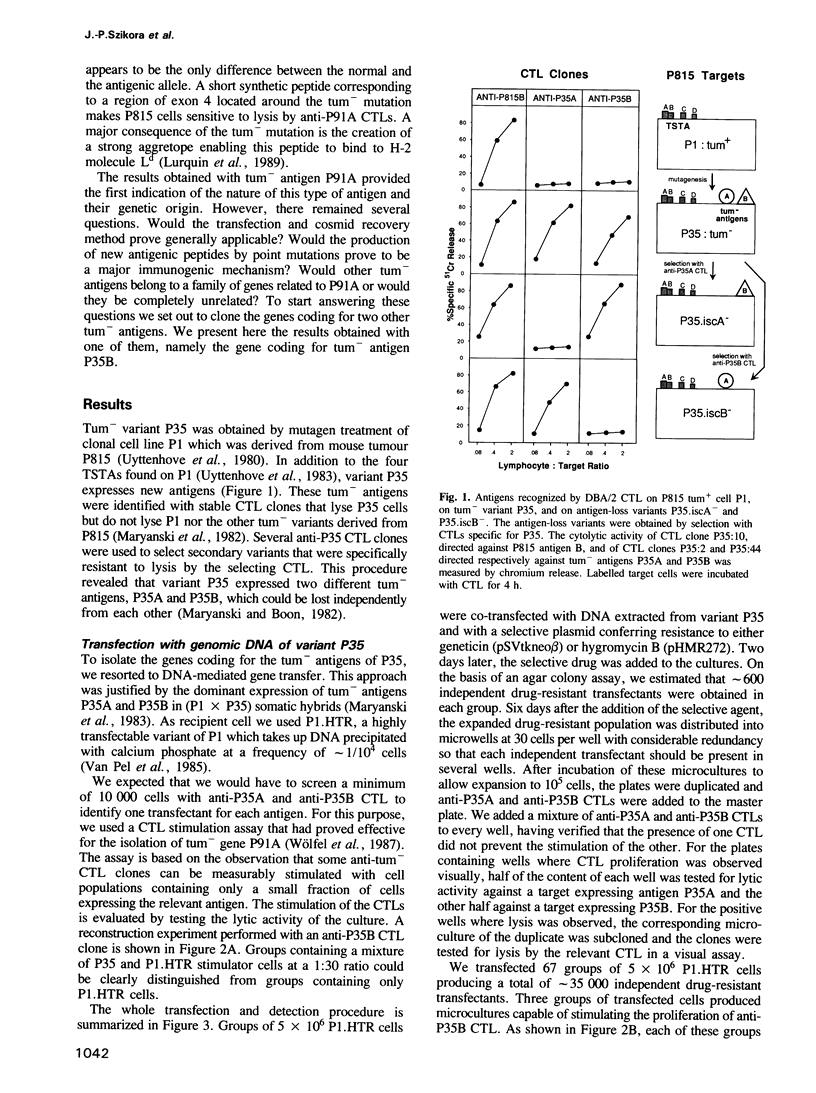


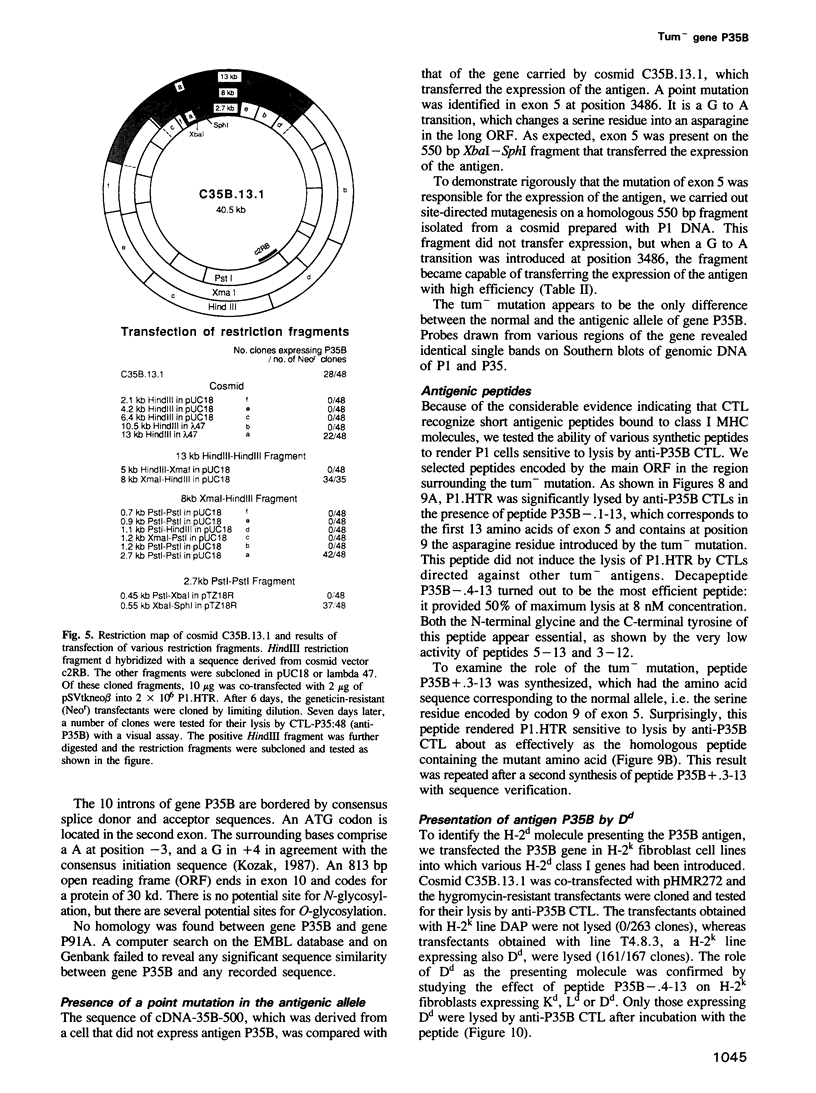

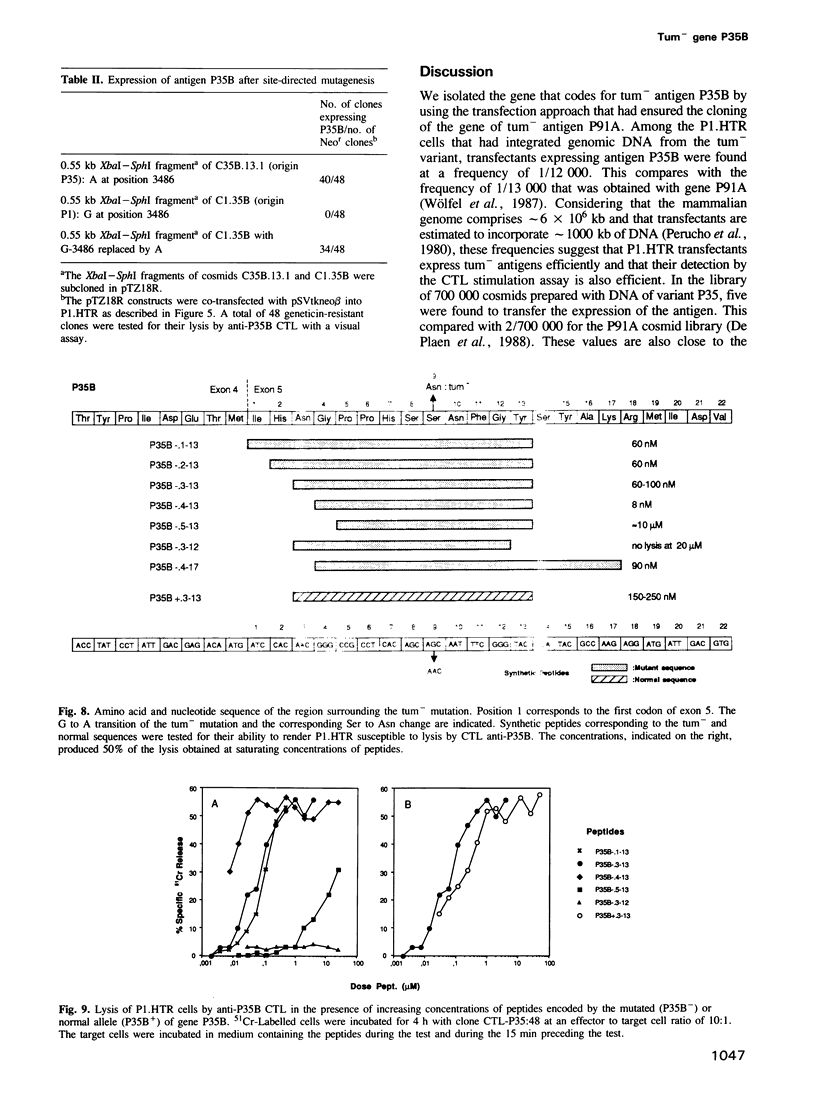
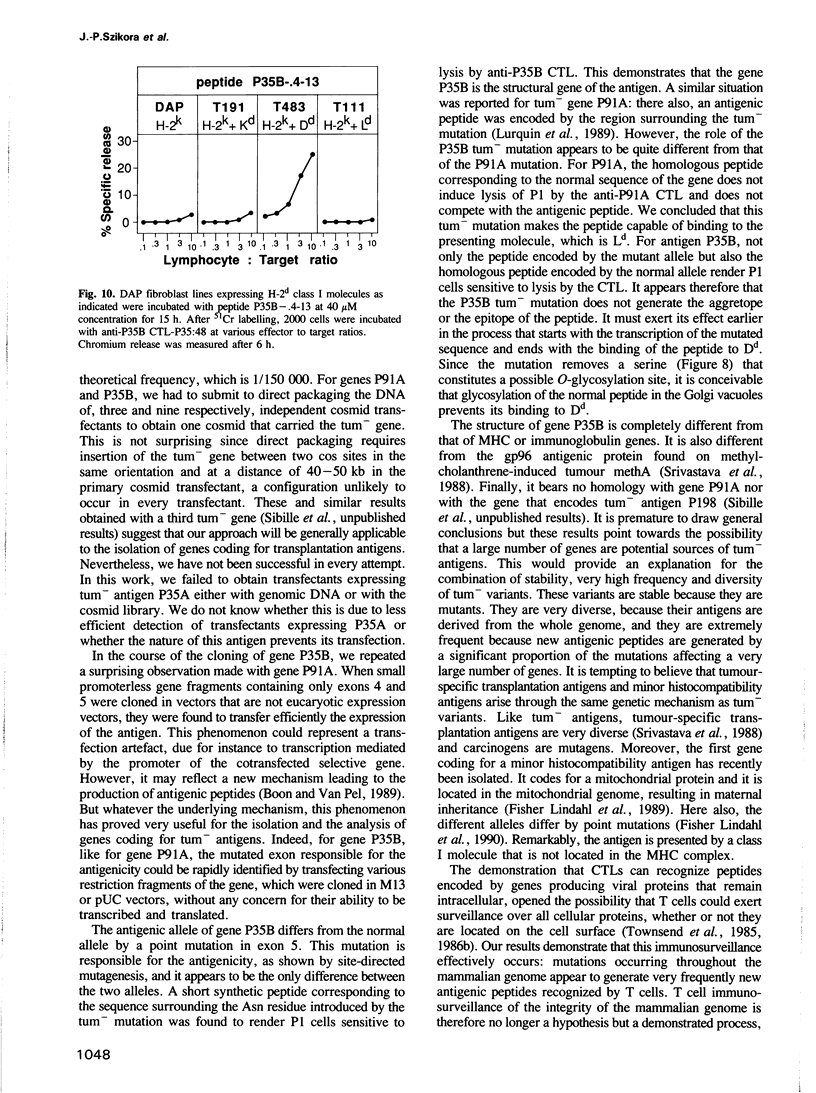


Images in this article
Selected References
These references are in PubMed. This may not be the complete list of references from this article.
- Auffray C., Rougeon F. Purification of mouse immunoglobulin heavy-chain messenger RNAs from total myeloma tumor RNA. Eur J Biochem. 1980 Jun;107(2):303–314. doi: 10.1111/j.1432-1033.1980.tb06030.x. [DOI] [PubMed] [Google Scholar]
- Bates P. F., Swift R. A. Double cos site vectors: simplified cosmid cloning. Gene. 1983 Dec;26(2-3):137–146. doi: 10.1016/0378-1119(83)90183-x. [DOI] [PubMed] [Google Scholar]
- Bernard H. U., Krämmer G., Röwekamp W. G. Construction of a fusion gene that confers resistance against hygromycin B to mammalian cells in culture. Exp Cell Res. 1985 May;158(1):237–243. doi: 10.1016/0014-4827(85)90446-x. [DOI] [PubMed] [Google Scholar]
- Boon T. Antigenic tumor cell variants obtained with mutagens. Adv Cancer Res. 1983;39:121–151. doi: 10.1016/s0065-230x(08)61034-9. [DOI] [PubMed] [Google Scholar]
- Boon T., Kellermann O. Rejection by syngeneic mice of cell variants obtained by mutagenesis of a malignant teratocarcinoma cell line. Proc Natl Acad Sci U S A. 1977 Jan;74(1):272–275. doi: 10.1073/pnas.74.1.272. [DOI] [PMC free article] [PubMed] [Google Scholar]
- Boon T., Van Pel A. T cell-recognized antigenic peptides derived from the cellular genome are not protein degradation products but can be generated directly by transcription and translation of short subgenic regions. A hypothesis. Immunogenetics. 1989;29(2):75–79. doi: 10.1007/BF00395854. [DOI] [PubMed] [Google Scholar]
- Boon T., Van Pel A. Teratocarcinoma cell variants rejected by syngeneic mice: protection of mice immunized with these variants against other variants and against the original malignant cell line. Proc Natl Acad Sci U S A. 1978 Mar;75(3):1519–1523. doi: 10.1073/pnas.75.3.1519. [DOI] [PMC free article] [PubMed] [Google Scholar]
- Boon T., Van Snick J., Van Pel A., Uyttenhove C., Marchand M. Immunogenic variants obtained by mutagenesis of mouse mastocytoma P815. II. T lymphocyte-mediated cytolysis. J Exp Med. 1980 Nov 1;152(5):1184–1193. doi: 10.1084/jem.152.5.1184. [DOI] [PMC free article] [PubMed] [Google Scholar]
- Corsaro C. M., Pearson M. L. Enhancing the efficiency of DNA-mediated gene transfer in mammalian cells. Somatic Cell Genet. 1981 Sep;7(5):603–616. doi: 10.1007/BF01549662. [DOI] [PubMed] [Google Scholar]
- De Plaen E., Lurquin C., Van Pel A., Mariamé B., Szikora J. P., Wölfel T., Sibille C., Chomez P., Boon T. Immunogenic (tum-) variants of mouse tumor P815: cloning of the gene of tum- antigen P91A and identification of the tum- mutation. Proc Natl Acad Sci U S A. 1988 Apr;85(7):2274–2278. doi: 10.1073/pnas.85.7.2274. [DOI] [PMC free article] [PubMed] [Google Scholar]
- Frohman M. A., Dush M. K., Martin G. R. Rapid production of full-length cDNAs from rare transcripts: amplification using a single gene-specific oligonucleotide primer. Proc Natl Acad Sci U S A. 1988 Dec;85(23):8998–9002. doi: 10.1073/pnas.85.23.8998. [DOI] [PMC free article] [PubMed] [Google Scholar]
- Frost P., Kerbel R. S., Bauer E., Tartamella-Biondo R., Cefalu W. Mutagen treatment as a means for selecting immunogenic variants from otherwise poorly immunogenic malignant murine tumors. Cancer Res. 1983 Jan;43(1):125–132. [PubMed] [Google Scholar]
- Grosveld F. G., Lund T., Murray E. J., Mellor A. L., Dahl H. H., Flavell R. A. The construction of cosmid libraries which can be used to transform eukaryotic cells. Nucleic Acids Res. 1982 Nov 11;10(21):6715–6732. doi: 10.1093/nar/10.21.6715. [DOI] [PMC free article] [PubMed] [Google Scholar]
- Henikoff S. Unidirectional digestion with exonuclease III creates targeted breakpoints for DNA sequencing. Gene. 1984 Jun;28(3):351–359. doi: 10.1016/0378-1119(84)90153-7. [DOI] [PubMed] [Google Scholar]
- Kozak M. An analysis of 5'-noncoding sequences from 699 vertebrate messenger RNAs. Nucleic Acids Res. 1987 Oct 26;15(20):8125–8148. doi: 10.1093/nar/15.20.8125. [DOI] [PMC free article] [PubMed] [Google Scholar]
- Kvist S., Roberts L., Dobberstein B. Mouse histocompatibility genes: structure and organisation of a Kd gene. EMBO J. 1983;2(2):245–254. doi: 10.1002/j.1460-2075.1983.tb01413.x. [DOI] [PMC free article] [PubMed] [Google Scholar]
- Lebacq-Verheyden A. M., Krystal G., Sartor O., Way J., Battey J. F. The rat prepro gastrin releasing peptide gene is transcribed from two initiation sites in the brain. Mol Endocrinol. 1988 Jun;2(6):556–563. doi: 10.1210/mend-2-6-556. [DOI] [PubMed] [Google Scholar]
- Lipman D. J., Pearson W. R. Rapid and sensitive protein similarity searches. Science. 1985 Mar 22;227(4693):1435–1441. doi: 10.1126/science.2983426. [DOI] [PubMed] [Google Scholar]
- Lurquin C., Van Pel A., Mariamé B., De Plaen E., Szikora J. P., Janssens C., Reddehase M. J., Lejeune J., Boon T. Structure of the gene of tum- transplantation antigen P91A: the mutated exon encodes a peptide recognized with Ld by cytolytic T cells. Cell. 1989 Jul 28;58(2):293–303. doi: 10.1016/0092-8674(89)90844-1. [DOI] [PubMed] [Google Scholar]
- Margulies D. H., Evans G. A., Ozato K., Camerini-Otero R. D., Tanaka K., Appella E., Seidman J. G. Expression of H-2Dd and H-2Ld mouse major histocompatibility antigen genes in L cells after DNA-mediated gene transfer. J Immunol. 1983 Jan;130(1):463–470. [PubMed] [Google Scholar]
- Maryanski J. L., Boon T. Immunogenic variants obtained by mutagenesis of mouse mastocytoma P815. IV. Analysis of variant-specific antigens by selection of antigen-loss variants with cytolytic T cell clones. Eur J Immunol. 1982 May;12(5):406–412. doi: 10.1002/eji.1830120509. [DOI] [PubMed] [Google Scholar]
- Maryanski J. L., Szpirer J., Szpirer C., Boon T. Immunogenic variants obtained by mutagenesis of mouse mastocytoma P815. VII. Dominant expression of variant antigens in somatic cell hybrids. Somatic Cell Genet. 1983 May;9(3):345–357. doi: 10.1007/BF01539143. [DOI] [PubMed] [Google Scholar]
- Maryanski J. L., Van Snick J., Cerottini J. C., Boon T. Immunogenic variants obtained by mutagenesis of mouse mastocytoma P815. III. Clonal analysis of the syngeneic cytolytic T lymphocyte response. Eur J Immunol. 1982 May;12(5):401–406. doi: 10.1002/eji.1830120508. [DOI] [PubMed] [Google Scholar]
- Nakamaye K. L., Eckstein F. Inhibition of restriction endonuclease Nci I cleavage by phosphorothioate groups and its application to oligonucleotide-directed mutagenesis. Nucleic Acids Res. 1986 Dec 22;14(24):9679–9698. doi: 10.1093/nar/14.24.9679. [DOI] [PMC free article] [PubMed] [Google Scholar]
- Perucho M., Hanahan D., Wigler M. Genetic and physical linkage of exogenous sequences in transformed cells. Cell. 1980 Nov;22(1 Pt 1):309–317. doi: 10.1016/0092-8674(80)90178-6. [DOI] [PubMed] [Google Scholar]
- Ploegh H. L., Orr H. T., Strominger J. L. Molecular cloning of a human histocompatibility antigen cDNA fragment. Proc Natl Acad Sci U S A. 1980 Oct;77(10):6081–6085. doi: 10.1073/pnas.77.10.6081. [DOI] [PMC free article] [PubMed] [Google Scholar]
- Ryser J. E., Cerottini J. C., Brunner K. T. Generation of cytolytic T lymphocytes in vitro. IX. induction of secondary CTL responses in primary long-term MLC by supernatants from secondary MLC. J Immunol. 1978 Feb;120(2):370–377. [PubMed] [Google Scholar]
- Srivastava P. K., Kozak C. A., Old L. J. Chromosomal assignment of the gene encoding the mouse tumor rejection antigen gp96. Immunogenetics. 1988;28(3):205–207. doi: 10.1007/BF00375860. [DOI] [PubMed] [Google Scholar]
- Townsend A. R., Bastin J., Gould K., Brownlee G. G. Cytotoxic T lymphocytes recognize influenza haemagglutinin that lacks a signal sequence. Nature. 1986 Dec 11;324(6097):575–577. doi: 10.1038/324575a0. [DOI] [PubMed] [Google Scholar]
- Townsend A. R., Gotch F. M., Davey J. Cytotoxic T cells recognize fragments of the influenza nucleoprotein. Cell. 1985 Sep;42(2):457–467. doi: 10.1016/0092-8674(85)90103-5. [DOI] [PubMed] [Google Scholar]
- Townsend A. R., Rothbard J., Gotch F. M., Bahadur G., Wraith D., McMichael A. J. The epitopes of influenza nucleoprotein recognized by cytotoxic T lymphocytes can be defined with short synthetic peptides. Cell. 1986 Mar 28;44(6):959–968. doi: 10.1016/0092-8674(86)90019-x. [DOI] [PubMed] [Google Scholar]
- Uyttenhove C., Maryanski J., Boon T. Escape of mouse mastocytoma P815 after nearly complete rejection is due to antigen-loss variants rather than immunosuppression. J Exp Med. 1983 Mar 1;157(3):1040–1052. doi: 10.1084/jem.157.3.1040. [DOI] [PMC free article] [PubMed] [Google Scholar]
- Uyttenhove C., Van Snick J., Boon T. Immunogenic variants obtained by mutagenesis of mouse mastocytoma P815. I. Rejection by syngeneic mice. J Exp Med. 1980 Nov 1;152(5):1175–1183. doi: 10.1084/jem.152.5.1175. [DOI] [PMC free article] [PubMed] [Google Scholar]
- Van Pel A., De Plaen E., Boon T. Selection of highly transfectable variant from mouse mastocytoma P815. Somat Cell Mol Genet. 1985 Sep;11(5):467–475. doi: 10.1007/BF01534840. [DOI] [PubMed] [Google Scholar]
- Van Pel A., Georlette M., Boon T. Tumor cell variants obtained by mutagenesis of a Lewis lung carcinoma cell line: immune rejection by syngeneic mice. Proc Natl Acad Sci U S A. 1979 Oct;76(10):5282–5285. doi: 10.1073/pnas.76.10.5282. [DOI] [PMC free article] [PubMed] [Google Scholar]
- Wigler M., Pellicer A., Silverstein S., Axel R. Biochemical transfer of single-copy eucaryotic genes using total cellular DNA as donor. Cell. 1978 Jul;14(3):725–731. doi: 10.1016/0092-8674(78)90254-4. [DOI] [PubMed] [Google Scholar]
- Wölfel T., Van Pel A., De Plaen E., Lurquin C., Maryanski J. L., Boon T. Immunogenic (tum-) variants obtained by mutagenesis of mouse mastocytoma P815. VIII. Detection of stable transfectants expressing a tum- antigen with a cytolytic T cell stimulation assay. Immunogenetics. 1987;26(3):178–187. doi: 10.1007/BF00365909. [DOI] [PubMed] [Google Scholar]



